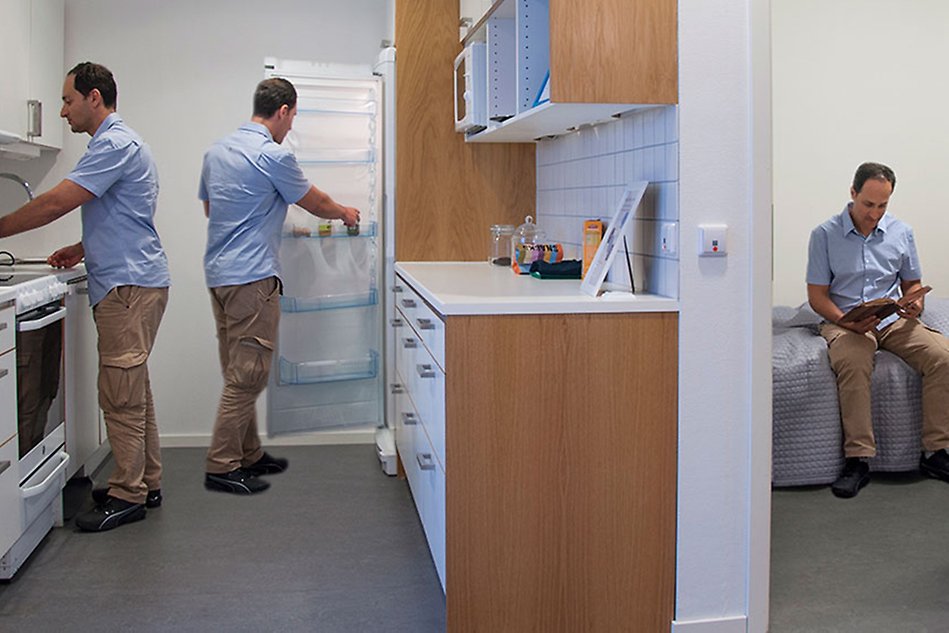Scary or safe when monitored day and night?
During three weeks in May, researcher Edison Pignaton de Freitas lived in the Halmstad Intelligent Home (HINT). Edison’s daily routines were monitored by the different sensors in the flat and collected data will be used to further develop the flat’s smart features. The close collaboration between Brazilian and Swedish researchers continues and health innovation, like the intelligent home, is the focus area.
Edison Pignaton de Freitas, Associate Professor at the Institute of Informatics at Federal University of Rio Grande do Sul (UFRGS) in Brazil, got his PhD at Halmstad University in 2011. His doctoral thesis was about wireless sensor networks. Since then his research focus has shifted towards Internet of Things, with applications in for example e-health. The connection to Halmstad remains – he is responsible for the Linnaeus-Palme exchange programme at the Institute of Informatics at UFRGS, which is also the reason for his duties at Halmstad University. Apart from being a test person at HINT, he was a Master thesis opponent and held seminars during his recent stay in Halmstad.

”Our goal is to increase the teacher and student exchanges between the School of Information Technology at Halmstad University and the Institute of Informatics at UFRGS. We want to deepen our collaboration in health innovation – both in education and in research”, says Edison Pignaton de Freitas.
Sensors for a helpful home
HINT is one example of the collaborative health innovation research projects. Jens Lundström and Wagner Ourique de Morais, both researchers at Halmstad University, are working with developing the smart technologies at HINT.
”The purpose with detecting movement and activities of the person living in an intelligent home is to create a personal model of activity patterns. If the person’s movements and activities deviates from the model, an alarm signal can be sent to relatives or health care services and help can arrive”, says Assistant Professor Jens Lundström.
Last year, Professor Álvaro Freitas Moreira from UFRGS also stayed at HINT and acted as a test person. Since then, the technology has been further developed.
”During Álvaro Freitas Moreira’s stay, we collected movement data from the flat’s many sensors – for example when he opened and closed doors or when he used the kitchen. This year, we have also installed thermal cameras and the sensor system is even more advanced. We can monitor the person staying in the flat during the night through bed sensors and we can determine if assistance is needed”, says Research Engineer Wagner Ourique de Morais.
Monitoring that does not feel intrusive
When asked how it was living at HINT during three weeks, Edison Pignaton de Freitas answers:
”It did not disturb me, which confirms that the system is working. The goal for the monitoring is to be as seamless as possible. No one wants to feel observed or controlled, so the equipment has to be integrated in the living space. It is of great importance that the research and development at HINT is multidisciplinary – apart from developing the technology, we also need the human and medical perspective in order to succeed in creating a safe and useful smart home.”
Text: Louise Wandel
About UFRGS
The Universidade Federal do Rio Grande do Sul, UFRGS (Federal University of Rio Grande do Sul) is a century-old educational institution, currently with over 30,000 students. It is centered in Porto Alegre, which is the capital city of the State of Rio Grande do Sul in southern Brazil. UFRGS offers academic programmes from all different knowledge fields, for all stages of education, ranging from elementary to graduate school. UFRGS has more than 700 registered groups working with basic or applied research from many different fields. In total approximately 14,000 people are involved in research activities, including undergraduate and graduate students, laboratory technicians, professors and visitors.
About the Linneaus-Palme programme
Linnaeus-Palme is a Sida funded exchange programme for teachers and students, either at undergraduate or advanced levels, at universities and colleges. The programme aims to strengthen partnerships between Swedish institutions for higher education and universities in developing countries. Swedish higher education institutions’ partnerships with universities from developing countries. The agreement is that a Linnaeus-Palme project will be mutually beneficial for both parties, and not to be considered as aid. Projects may be subsidised for up to eight years.
The collaboration between Halmstad University and the Brazilian university UFRGS is one of the exchanges funded by the Linnaeus-Palme programme and health innovation is the theme. In the long term, the idea is that the collaboration will strengthen the education programmes and research in computer science and health technologies at both universities. One main target is that UFRGS will add its own health innovation themes to its programmes, as has been done at Halmstad University.
Application information for students External link, opens in new window. (in Swedish) – the last date for applying for an exchange in 2018 is September 1, 2017.
Application information for research groups External link, opens in new window. (in Swedish).
About HINT
Halmstad Intelligent Home (HINT) provides researchers, students, and industry a technology-equipped, realistic home environment. The flat makes it possible, among other things, to conduct experiments and studies related to monitoring and assistance in smart and intelligent environments, and social robotics. Communication about and discussions around a smart home are facilitated by HINT, and the goal is to create a strong collaboration between researchers and the community. HINT is funded by the Center for Applied Intelligent Systems Research (CAISR) at the School of Information Technology. The Centre for Health Technology Halland (HCH) is also involved in the development of HINT.

